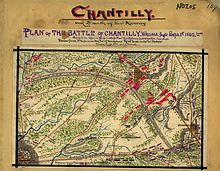Battle of Chantilly
Defeated in the Second Battle of Bull Run on August 30, Union Maj. Gen. John Pope ordered his Army of Virginia to retreat to Centreville.
More importantly, Lee's decision bought time for the Union to push to the front the Army of the Potomac's II, V, and VI Corps, which had been brought from the Peninsula and—much to Maj. Gen. George B. McClellan's dismay—placed under Pope's command.
The defeat at Second Bull Run seemed to have shattered his nerve and Pope was unsure what to do next; he knew Washington wanted an attack but he feared Lee might strike first and destroy his reforming force before it was ready to fight again.
Calling a conference of his corps commanders—something he had been loath to do previously in the Virginia Campaign—in his Centreville headquarters, Pope agreed with their decision to retreat further into the Washington defenses.
Jackson's men, hungry and worn, moved slowly and bivouacked for the night at Pleasant Valley, three miles northeast of Centreville.
A staff officer arrived from the Germantown position to report that a heavy force of cavalry had shelled the intersection before retreating.
But when, hours later, two Union cavalrymen reported seeing a large mass of infantry marching east down the Little River Turnpike, Pope realized that his army was in danger.
He countermanded actions preparing for an attack and directed the army to retreat from Centreville to Washington; he also sent out a series of infantry probes up the roads that Lee might use to reach his troops as they pulled back.
But at the same time, he continued his movement in the direction of Washington, sending McDowell's corps to Germantown (on the western border of modern-day Fairfax, Virginia), where it could protect the important intersection of Warrenton Pike and Little River Turnpike that the army needed for the retreat.
[7] Jackson resumed his march to the south, but his troops were tired and hungry and made poor progress as the rain continued.
[8] A severe thunderstorm erupted about this time, resulting in limited visibility and an increased dependence on the bayonet, as the rain soaked the ammunition of the infantry and made it useless.
The Union army withdrew to Germantown and Fairfax Court House that night, followed over the next few days by retreating to the defenses of Washington.
[13] A small yard located within the nearby Fairfax Towne Center has been preserved to mark the area crossed by Confederate troops to get to the Ox Hill battlefield.


